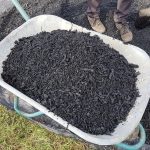Compost: Benefits and quality parameters
Compost is a decomposed organic material used as a soil amendment. It is created in a process called “composting”, which is an aerobic process in which microorganisms break-down organic waste, either plant material or animal wastes.
Adding compost to soil increases the organic matter content of the soil, including humus, which is the stable form of organic matter that cannot be further decomposed by microorganisms.
Compost has multiple benefits:
- Improves soil structure
- Improves soil water retention
- Increases soil CEC
- Contains plant nutrients
- Improves the availability of micronutrients
- Enhances microbial activity in the soil
Soil structure. The decomposed organic matter binds soil particles together, creating soil aggregates. In clay soil, humus added with the compost surrounds the clay particles and cause them to aggregate into larger clumps. Therefore, it improves soil aeration and water infiltration, enhances root system growth and reduces soil crusting, which is a result of high sodium levels in the soil.
Water retention. Decomposed organic matter can hold a large amount of water, relative to its weight. Therefore, adding compost to soil improves the water holding capacity of the soil.
Plant nutrients. Compost contains a certain amount of essential nutrients. The actual nutrient content of the compost varies between compost samples, even if they are of the same type. Most composts contain essential plant nutrients, such as nitrogen, phosphorus, potassium, iron, copper, zinc and boron. However, compost cannot provide sufficient amount of nutrients for commercial crops.
It is important to take into consideration that, in addition to the relatively low concentration of nutrients, compost releases nutrients over a long period of time – months or years. Therefore, only a small amount of nutrients is readily available after compost application.
| Nutrient | Typical optimum range (% of dry weight) |
| Nitrogen (N) | 1-2 |
| Phosphorus (P) | 0.3-0.9 |
| Potassium (K) | 0.5-1.5 |
| Calcium (Ca) | 1.5-3.5 |
| Magnesium (Mg) | 0.25-0.7 |
| Sulfur (S) | 0.25-0.8 |
Availability of micronutrients. The humic substances in compost form chelate complexes with micronutrients in soil, keeping them in the soil solution and hence making them available for plants.
Compost quality parameters
Moisture content. An ideal compost would have a moisture content of 40% to 60%. Lower moisture levels result in limited microbial activity and slower decomposition. High moisture levels may produce anaerobic conditions and the compost will develop a bad smell.
Organic matter. A stable compost contains 25% to 65% organic matter, expressed as dry weight. Less than 25% may indicate that sand or soil were mixed into the compost. Organic matter content above 65% may indicate that the decomposition was not completed.
C:N ratio. The ratio of total carbon and total nitrogen in the compost, on a dry weight basis. For example, C:N ratio of 30:1 means the compost contains 30 times as much carbon as nitrogen.
The initial C:N ratio of the compost is one of the most important properties required for proper composting.
Microorganisms are using carbon as an energy source and nitrogen as a building block for proteins. They require more carbon than nitrogen, where the ideal C:N ratio is between 25:1 to 30:1.
A C:N ratio higher than 40:1 may result in slow decomposition and longer composting time, as there may be not enough nitrogen for microorganisms to grow. When a compost with high C:N ratio is added to soil, soil microorganisms will have to find additional nitrogen sources in order to consume the composted material. This may result in nitrogen immobilization, less nitrogen will available for the crop and increased rates of nitrogen fertilizer may be required.
A C:N ratio lower than 20 means the compost contains more nitrogen, in relation to carbon. This excess nitrogen may be lost to the atmosphere as ammonia gas, which also gives the compost a bad smell. Adding a compost with a low C:N ratio to the soil supply available nitrogen to plants.
Composts with large amounts of green material will have a low C:N ratio, while composts with more dry material will have a higher C:N ratio.
Salinity. Compost materials contain salts in the form of mineral ions. Due to the high variability in crop sensitivity to salts, application rate standards based on the salt content of the compost are not defined. However, compost with EC of 0-2 ds/m can be safely applied at any application rate. Compost with EC of 2-4 ds/m can be applied at moderate application rates and if the EC is greater than 4 ds/m, then application rate should be considered carefully.







